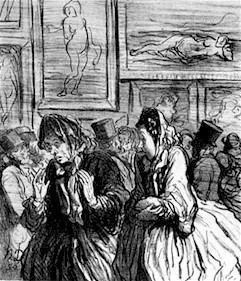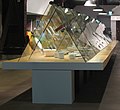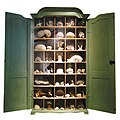The Museums Portal
A museum is an institution dedicated to displaying and/or preserving culturally or scientifically significant objects. Many museums have exhibitions of these objects on public display, and some have private collections that are used by researchers and specialists. Museums host a much wider range of objects than a library, and usually focus on a specific theme, such as the arts, science, natural history or local history. Public museums that host exhibitions and interactive demonstrations are often tourist attractions, and many attract large numbers of visitors from outside their host country, with the most visited museums in the world attracting millions of visitors annually.
Since the establishment of the earliest known museum in ancient times, museums have been associated with academia and the preservation of rare items. Museums originated as private collections of interesting items, and not until much later did the emphasis on educating the public take root. (Full article...)
Selected museum
The Louvre (English: /ˈluːv(rə)/ LOOV(-rə)), or the Louvre Museum (French: Musée du Louvre [myze dy luvʁ] ), is a national art museum in Paris, France, and one of the most famous museums in the world. It is located on the Right Bank of the Seine in the city's 1st arrondissement (district or ward) and home to some of the most canonical works of Western art, including the Mona Lisa, Venus de Milo, and Winged Victory. The museum is housed in the Louvre Palace, originally built in the late 12th to 13th century under Philip II. Remnants of the Medieval Louvre fortress are visible in the basement of the museum. Due to urban expansion, the fortress eventually lost its defensive function, and in 1546 Francis I converted it into the primary residence of the French kings.
The building was redesigned and extended many times to form the present Louvre Palace. In 1682, Louis XIV chose the Palace of Versailles for his household, leaving the Louvre primarily as a place to display the royal collection, including, from 1692, a collection of ancient Greek and Roman sculpture. In 1692, the building was occupied by the Académie des Inscriptions et Belles-Lettres and the Académie Royale de Peinture et de Sculpture, which in 1699 held the first of a series of salons. The Académie remained at the Louvre for 100 years. During the French Revolution, the National Assembly decreed that the Louvre should be used as a museum to display the nation's masterpieces.
The museum opened on 10 August 1793 with an exhibition of 537 paintings, the majority of the works being royal and confiscated church property. Because of structural problems with the building, the museum was closed from 1796 until 1801. The collection was increased under Napoleon and the museum was renamed Musée Napoléon, but after Napoleon's abdication, many works seized by his armies were returned to their original owners. The collection was further increased during the reigns of Louis XVIII and Charles X, and during the Second French Empire the museum gained 20,000 pieces. Holdings have grown steadily through donations and bequests since the Third Republic. The collection is divided among eight curatorial departments: Egyptian Antiquities; Near Eastern Antiquities; Greek, Etruscan, and Roman Antiquities; Islamic Art; Sculpture; Decorative Arts; Paintings; Prints and Drawings.
The Musée du Louvre contains approximately 500,000 objects and displays 35,000 works of art in eight curatorial departments with more than 60,600 m2 (652,000 sq ft) dedicated to the permanent collection. The Louvre exhibits sculptures, objets d'art, paintings, drawings, and archaeological finds. At any given point in time, approximately 38,000 objects from prehistory to the 21st century are being exhibited over an area of 72,735 m2 (782,910 sq ft), making it the largest museum in the world. It received 8.9 million visitors in 2023, 14 percent more than in 2022, though below the 10.1 million visitors it received in 2018. The Louvre is the most-visited museum in the world, ahead of the Vatican Museums. (Full article...)
Selected interior image
Selected general article

An art exhibition is traditionally the space in which art objects (in the most general sense) meet an audience. The exhibit is universally understood to be for some temporary period unless, as is occasionally true, it is stated to be a "permanent exhibition". In American English, they may be called "exhibit", "exposition" (the French word) or "show". In UK English, they are always called "exhibitions" or "shows", and an individual item in the show is an "exhibit".
Such expositions may present pictures, drawings, video, sound, installation, performance, interactive art, new media art or sculptures by individual artists, groups of artists or collections of a specific form of art. (Full article...)
Did you know...
- ... that the American Pigeon Museum & Library keeps a flock of hundreds of pigeons for public viewing?
- ... that Ashton Hawkins arranged for the construction of the West Wing of the Metropolitan Museum of Art in New York City, to house the Temple of Dendur?
- ... that the Felix M. Warburg House was converted into the Jewish Museum after nearly being replaced by apartments?
- ... that while Joseph Longworth thought that he would be remembered only as "the son of his father and the father of his son", there is today a wing of the Cincinnati Art Museum named for him?
- ... that Ukrainian artist Kateryna Antonovych worked at Prague's Museum of Ukraine's Struggle for Independence before the US Army Air Forces bombed it?
- ... that squatters in Hamburg briefly occupied the former Erotic Art Museum?
Get involved
For editor resources and to collaborate with other editors on improving Wikipedia's Museums-related articles, see WikiProject Museums.
Selected exterior image
Selected type of museum

A ceramics museum is a museum wholly or largely devoted to ceramics, usually ceramic art. Its collections may also include glass and enamel, but typically concentrate on pottery, including porcelain. Most national collections are in a more general museum covering all of the arts, or just the decorative arts. However, there are a number of specialized ceramics museums, with some focusing on the ceramics of just one country, region or manufacturer. Others have international collections, which may be centered on ceramics from Europe or East Asia or have a more global emphasis.
Outstanding major ceramics collections in general museums include The Palace Museum, Beijing, with 340,000 pieces, and the National Palace Museum in Taipei city, Taiwan (25,000 pieces); both are mostly derived from the Chinese Imperial collection, and are almost entirely of pieces from China. In London, the Victoria and Albert Museum (over 75,000 pieces, mostly after 1400 CE) and British Museum (mostly before 1400 CE) have very strong international collections. The Metropolitan Museum of Art in New York and Freer Gallery of Art in Washington DC (12,000, all East Asian) have perhaps the best of the many fine collections in the large city museums of the United States. The Corning Museum of Glass, in Corning, New York, has more than 45,000 glass objects. (Full article...)


















































